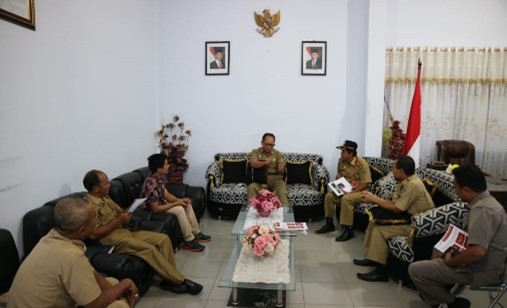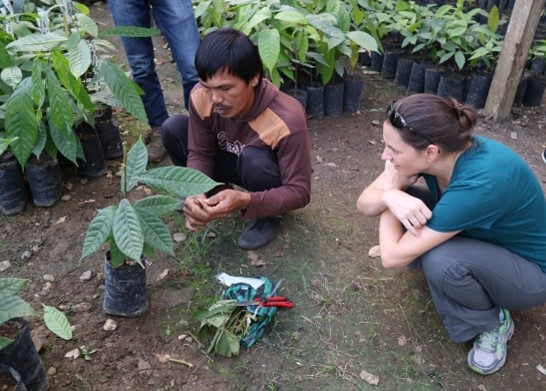Reminiscing on Field Visits: A Day Upcountry
By Megan Willis, Sustainability Lead
For a sustainability practitioner, being physically disconnected from my work during the pandemic has been unusual and difficult. Like any job, I handle my fair share of “desk work,” but what’s unique in my role is that it’s all about impact. All of the day-to-day brings positive change to rural farming communities, which I can personally experience during fields visits. In these, my team has the opportunity to talk to farmers and traders in the Cargill Cocoa Promise program in Indonesia and I can find out first-hand how well we are delivering services. If we need to improve, I am empowered to drive changes in our program to ensure livelihoods, communities, and landscapes all continue to thrive. What actually happens on a field visit and what am I learning? Follow me on a day in the #CargillLife, upcountry-style:
6:00am – The Day Begins. The team picks me up early from my hotel in Makassar, Sulawesi so that we can beat traffic on the way out of town. We grab breakfast at an Indomaret along the way – chocolate buns sprinkled with cheese, anyone?

10:00am – First order of the day! Greeting the local district government. At the beginning of the day, it’s important and culturally appropriate for us to let the bupati (regency head) know we are there and to provide an update on the work we are doing with his or her constituents. Neither the government nor private sector can alone improve farmer livelihoods, we must work together and understand each other’s perspective.

11:00am – Nursery Visit. This is where the cocoa journey truly begins. These nurseries are typically owned by advanced farmers in our network, whom we support to produce and sell thousands of cocoa and shade tree seedlings to other farmers in their area. While here, we chat about the nursery operations and finances, the health of the planting materials, and maybe even catch a training session on grafting. Since the tools are very sharp and the urgent care centre may be quite far, I prefer to watch, thanks!
12:00pm – Lunch! My team always tells me the food is “not so spicy” and it’s almost always very spicy, but what can I do? [Not pictured: tears running down my face while I eat]
1:00pm – Arrival to the Cocoa Farm…sort of. Our vehicle can only bring us so far, and cocoa farms are rarely right next to the road, so we have to walk for a while to reach the farm itself. Actual thought from when I saw this bridge: “please, please tell me the cocoa farm is on the other side.” Yay, it was!
1:30pm – Finally! Arrival at the cocoa farm. Once we are on the farm, we spend a long time talking with the farmer to understand if he or she likes the training and individual coaching we provide and if they are applying the Good Agricultural Practices that were taught. Every year, a subset of our 25,000 partner farmers are audited under the UTZ Certification System (soon to become Rainforest Alliance), so it’s important that everyone adopts the required practices and their cocoa can continue to be considered sustainably-sourced.
As we chat, the farmer’s designated coach updates the farmer’s record in our digital platform, CocoaTrace, designed by Koltiva, an Indonesia-based tech start-up. We may also update the map of the farm, which we use to ensure that our network farms are not in protected areas nor contributing to deforestation.
At some point in every farm visit, we’ll taste the raw cocoa pods. The cocoa bean is covered in a white pulp that’s actually very sweet, with the texture of soursop, while the bean itself is extremely bitter – neither part tastes anything like the chocolate that we know and love, but it’s still quite an experience!
2:30pm – Engaging with the cocoa farming community. The cocoa pods weren’t really a sufficient snack, so it’s a good thing we’re stopping by our host farmer’s village for a community gathering. My favourite villages will know I’m coming and will serve fried breadfruit with a sambal that’s not too spicy! While here, we talk with community members about their lives and work, both within cocoa and outside. Since entire families tend to join, it’s also a good time for us to give reminders about appropriate tasks for children who help on their family farms after school. Our community-based Child Labor Monitoring and Remediation System that helps community members to identify and intervene in potential cases in their villages. This program kicked off just as the pandemic (and travel restrictions) hit and will reach around 6,000 households this year, so in future field visits, understanding the impact of this work will become an important part of our day.
4:00pm – Trader Visit and Farmer Premium Distribution Ceremony. In our last stop of the day, we visit one of our certified sustainable traders and learn how the harvest season is going. We do a physical check to ensure that the sustainable cocoa beans they’ve purchased remain separated from other beans. This is also where we check the functionality of the traceability system, which matches the farmer record with the physical bean shipments. This is what provides transparency to our customers and end consumers about our supply chain.
While we’re at the trader’s warehouse, we get to see how all of the farmer’s hard work pays off…literally! It’s a standard requirement that farmers receive their sustainability premiums as a stand-alone payment and we typically distribute over US$200k each year. We help our farmers to open bank accounts so that we can make secure digital payments, but for those still hesitant about banking (very common in rural areas), we distribute cash. This is a tangible showing of the positive impact sustainability programs have on farmers. The visible pride and smiles on farmer faces are a huge source of motivation for me in my role.
6:00 – 11:00pm – A Successful Day Concludes. Throughout the drive back to Makassar, we keep our fingers crossed that we make it before the kitchen closes at my hotel. The team will join me there for a well-earned dinner (and a cold Bintang for some of us) and some socializing. Now that we know our sustainable sourcing system is in good order, it’s time to sell and deliver our sustainable cocoa to customers…but that’s a different day in my #CargillLife. For now, time to sleep!

